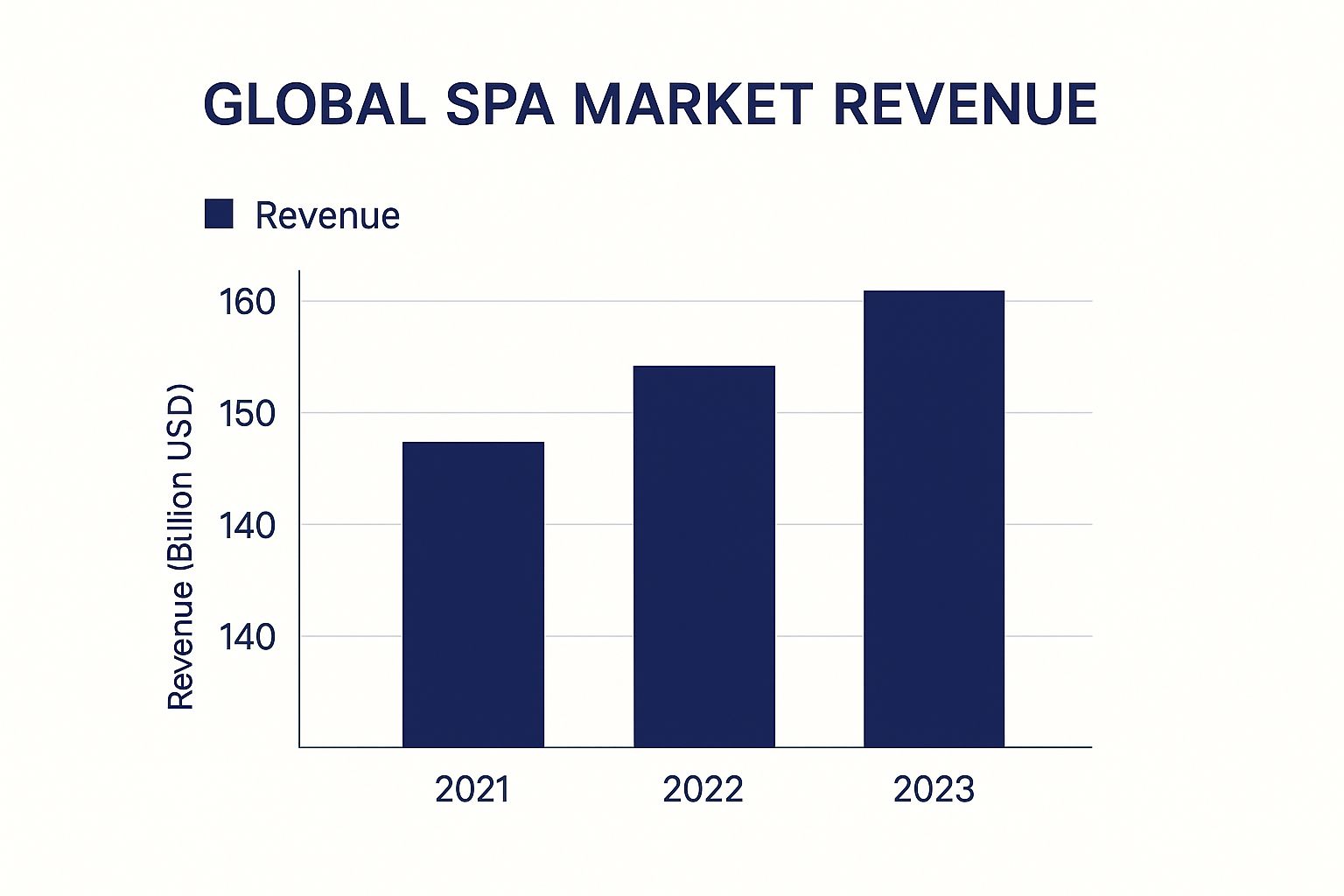Your Winning Business Plan Spa Guide

A spa business plan is so much more than a dry document you hand over to a lender. Think of it as your strategic roadmap, the very blueprint for building a successful, thriving business. It’s where you’ll hash out everything from your core mission and service menu to your financial projections and marketing tactics.
Getting this down on paper ensures every decision you make—from the big investments to the tiny details—is purposeful and perfectly aligned with your long-term goals.
Building the Foundation of Your Spa Business Plan

Before diving into spreadsheets, you need to define the soul of your business. This foundational step makes every other part of your business plan for a spa clearer and more compelling. It separates a generic spa from a memorable brand that clients connect with. This is your emotional blueprint that will guide everything from the scent that greets clients to the tone of your social media.
Crafting a Powerful Mission and Vision
Your mission and vision statements are practical tools that shape your decisions and attract the right clients and team members. Don't skip this step.
-
Action Step 1: Write Your Mission Statement. Answer these three questions to define your purpose: What do you do? Who do you serve? How do you do it? Combine them into a single, clear sentence.
- Example: "To provide a tranquil urban escape for busy professionals through personalized, results-driven skincare and massage therapy."
-
Action Step 2: Write Your Vision Statement. Describe the future impact you want to make. Where do you see your spa in five years?
- Example: "To become the community's most trusted destination for holistic wellness and self-care."
Use these statements as a filter. When faced with a decision—like adding a new service—ask, "Does this align with our mission and get us closer to our vision?"
Your mission is your compass. It ensures that even when you're overwhelmed with daily operations, every choice you make is steering the business in the right direction. This clarity is what builds a brand that lasts.
Defining Your Unique Spa Identity
Now, let's turn your mission into a tangible experience. Your brand identity determines your target audience, services, and decor.
Action Step: Choose Your Core Concept. Pick one clear identity to avoid trying to be everything to everyone. This strategic choice will dictate your equipment costs, staff training, and marketing.
Consider these distinct concepts:
-
The Serene Wellness Retreat: Focus on holistic healing and tranquility. Your action items would be sourcing organic product lines, partnering with local yoga studios, and centering your menu on services like aromatherapy and reflexology.
-
The High-Tech Medi-Spa: Focus on clinical results. Your action items would be investing in advanced technology (like lasers and microneedling devices), hiring staff with medical aesthetics certifications, and marketing visible skin transformations.
-
The Luxury Day Spa: Focus on an indulgent, premium experience. Your action items would be designing high-end treatment packages, sourcing plush robes and amenities, and training staff for five-star customer service.
By carving out your niche early, you create a brand that resonates deeply with a specific group of clients, making them feel like your spa was created just for them.
Defining Your Spa Concept and Service Menu
Your spa's concept is its heartbeat, dictating every client interaction and design choice. It transforms your brand from an idea into an irresistible experience. A strong concept simplifies decisions, ensuring every element, from product lines to pricing, reinforces your unique brand story.
Carving Out Your Niche
To succeed in a crowded market, you must become the go-to expert for a specific need. This focused approach makes your marketing more effective and your brand unforgettable.
Action Step: Identify a Market Gap. Research your local area. Is there a need that isn't being met?
- The Clinical Skincare Hub: If your area lacks results-driven skincare, focus here. Build a menu with medical-grade products and advanced technologies like chemical peels, microneedling, and LED therapy.
- The Eco-Conscious Sanctuary: If local clients value sustainability, this is your niche. Build your brand around organic products, clean wellness, and eco-friendly practices. This attracts clients whose values align with yours.
- The Express Urban Getaway: In a bustling downtown, convenience is key. Create a menu of high-impact services that fit into a lunch break, like 30-minute facials and express massages, targeting busy professionals.
The demand for these kinds of experiences is only growing. This chart shows a steady climb in the global spa market's revenue, proving that consumers are more than willing to invest in their well-being.

This consistent growth is fantastic news for spa owners. It confirms there’s a strong appetite for wellness, reinforcing just how valuable it is to create a unique and appealing spa concept that stands out.
Building a Profitable Service Menu
Now, build the menu that brings your concept to life. Every treatment should feel intentional and speak directly to your ideal client. Focus on a core set of signature services you can execute flawlessly.
Action Step: Structure Your Menu for Profit. Design your menu with a strategic mix of offerings:
- Core Services: Identify your 3-5 "bread-and-butter" treatments. These are what your spa will become known for, like a signature anti-aging facial.
- Premium Packages: Bundle services into an immersive experience. For example, a "Bridal Glow" package could combine a facial, body scrub, and manicure.
- High-Margin Add-Ons: List 3-5 small, complementary services that can be easily added to a core treatment, such as aromatherapy, a collagen eye mask, or a hot stone enhancement. This is a simple way to boost your average ticket price.
A well-designed service menu is more than a price list; it's a strategic marketing tool. It guides clients toward your most profitable offerings and tells a compelling story about the unique value your spa provides.
Research shows a clear consumer preference for high-value experiences. While standard massage therapies make up a huge 39% of the market, it's the luxury spa services that drive 54% of the total revenue. This tells us that clients are absolutely willing to pay more for premium packages and specialized treatments that feel exclusive.
Pricing Your Services For Success
Setting prices requires balancing your costs, brand value, and local competition. Avoid copying a competitor's price list without understanding your own numbers.
Action Step: Calculate Your Cost Per Service. For each service, add up the cost of products, disposable supplies, a fraction of your overhead (rent, utilities), and the provider's wage for the duration of the service. Once you have this baseline, add your desired profit margin.
Your brand positioning also dictates price. A luxury spa with premium amenities should charge significantly more than an express-service spot. Your pricing signals the quality you promise. For more specific strategies, our guide on crafting a compelling salon service menu has some fantastic tips you can adapt for your spa.
Sample Spa Service Pricing Tiers
| Service Category | Entry-Level Service (e.g., Express Facial) | Mid-Tier Service (e.g., Signature Massage) | Premium Service (e.g., Ultimate Rejuvenation Package) |
|---|---|---|---|
| Price Point | $75 – $95 | $120 – $150 | $250 – $400 |
| Duration | 30 minutes | 60 – 75 minutes | 3 – 4 hours |
| Target Client | New clients, budget-conscious, busy professionals | Regulars, clients seeking relaxation and core benefits | Gift certificate recipients, special occasions, clients seeking total immersion |
| Profit Margin | Lower (attracts volume) | Moderate (stable revenue driver) | Highest (boosts overall profitability) |
This structure ensures you cater to different needs and budgets while guiding clients toward your most profitable experiences. Your prices should feel fair to your clients and, just as importantly, fair to you.
Figuring Out Your Market and Competition
A great spa can't succeed in a bubble. You must understand your ideal clients and the other spas competing for their attention. This research is a core part of your business plan for a spa that turns your idea into a real-world strategy. The goal is to find your unique sweet spot and become the obvious choice for your target audience.
Who Is Your Dream Client?
To attract your dream clients, you have to know them deeply. Go beyond basic demographics and get inside their heads to understand their motivations, habits, and what they truly want from a spa experience.
Action Step: Create a Detailed Client Persona. Don't just settle for "women aged 30-50." Get specific by answering these questions:
- What’s their lifestyle like? Is she a stressed corporate professional needing a quick lunch-break treatment, or a new mom craving uninterrupted quiet?
- How do they spend their money? Is self-care a monthly investment or a rare splurge?
- What are their biggest frustrations? Is she battling chronic stress, worried about a specific skin issue, or searching for a holistic vibe she can't find elsewhere?
Use these answers to build a persona. For example, "Wellness Wendy" is a 38-year-old yoga instructor who loves organic products, seeks holistic treatments, and will pay a premium for a serene, eco-conscious experience. Now you can aim every marketing message directly at her.
How to Scope Out the Competition (Without Spending a Dime)
Understand what competitors do well, where they fall short, and how you can offer something better. You don’t need a huge budget for this detective work.
Action Step: Conduct a Competitive Analysis. Spend a few hours exploring their online presence from a potential customer's perspective.
- Analyze Their Website: Is it easy to navigate and book an appointment? Does the branding feel modern or dated? Note the language they use to describe their services.
- Review Their Social Media: What are they posting on Instagram or Facebook? Are they showing client results or just pushing discounts? Check their engagement—are people commenting and asking questions?
- Read Every Single Online Review: This is a goldmine. Read 5-star reviews to see what people love. Pay even closer attention to 3- and 4-star reviews to find unmet needs. A comment like, "The massage was incredible, but the waiting area felt chaotic," reveals a gap you can fill.
Competitive analysis isn't about copying what everyone else is doing. It’s about finding the empty spaces—the services they aren't offering, the client experience they're totally neglecting, or the niche audience they're completely ignoring. That empty space is where you win.
This research is more important than ever. The global spa services market is projected to hit around USD 147.11 billion by 2030, growing at a solid 7.5% each year. To grab your piece of that pie, you have to stand out. You can read the full research about these spa market trends to get a better handle on the opportunity.
Finding Your "Thing"—Your Unique Selling Proposition
After profiling your ideal client and the competition, you can define your Unique Selling Proposition (USP). This is the one thing that makes your spa different and better. It’s the clear answer to, "Why should I choose you?"
Action Step: Write Your USP. Based on your research, complete this sentence: "Unlike other spas in [Your City], we are the only one that [Your Unique Thing]."
Your USP could be your focus on clinical-grade facials, your commitment to using only local, organic products, or your menu of express services for busy people. For instance, if every local spa is either ultra-luxury or no-frills, your USP could be "affordable luxury." You've found the gap; now you're positioned to fill it perfectly.
Fine-Tuning Your Operations and Management Team
You’ve defined your concept; now it’s time to build the internal framework. The operations section of your business plan is where you map out the practical, day-to-day reality of running a smooth, efficient, and legally sound business. This section demonstrates to investors that you have a concrete plan for real-world challenges.
Choosing Your Legal Structure
This critical decision impacts your personal liability, taxes, and funding options. Choose the structure that fits your long-term vision.
Action Step: Select Your Business Structure. Consult with a legal or financial advisor to make the best choice.
- Sole Proprietorship: The simplest to set up for a solo owner. However, there's no legal separation between you and the business, meaning your personal assets are at risk.
- Limited Liability Company (LLC): A popular choice that protects your personal assets from business debts. It offers a great balance of protection and flexibility.
- Corporation (S-Corp or C-Corp): A more complex structure ideal if you plan to seek venture capital. It offers significant liability protection but comes with more formal requirements.
Building Your Dream Team
Your team brings your vision to life. A clear staffing plan in your business plan shows you've thought through who you need to hire and what their roles will be.
Action Step 1: Create an Organizational Chart. Sketch out a simple chart showing who is responsible for what, even if you're the only manager initially. This clarifies roles as you grow.
Your team isn’t just a line item in your budget—they are your brand ambassadors. Hiring the right people who believe in your mission is the single most important operational decision you will make.
Action Step 2: Define Key Roles. List the essential positions for a successful launch:
- Licensed Professionals: Estheticians, massage therapists, and nail technicians who will deliver your core services.
- Front Desk Coordinator/Spa Concierge: The first and last impression for every client, managing appointments and ensuring a seamless experience.
- Spa Manager/Owner: The leader overseeing daily operations, marketing, inventory, and staff management.
The wellness industry is booming, with employment recently growing by 1.6% to 376,200 workers. This thriving marketplace means there's a robust pool of skilled professionals to build your team from.
Action Step 3: Plan Your Onboarding. A structured onboarding process is non-negotiable. Use an employee training manual template to create clear guidelines on brand standards and service protocols. This ensures quality and consistency from day one.
Crafting Your Spa's Marketing and Sales Game Plan
A beautiful spa needs a steady stream of clients. This section of your business plan for a spa outlines a multi-channel marketing and sales strategy to keep your appointment book full. It's about building a brand that attracts your ideal client and turns them into loyal fans.
Building Your Digital Footprint
A solid online presence is non-negotiable. This is where most future clients will discover you and form their first impression. The goal is to be visible and engaging where your target audience spends their time.
Actionable Digital To-Do List:
- Optimize for Local SEO: When someone searches "spa near me," you must appear. Set up and fully optimize your Google Business Profile with high-quality photos, accurate hours, and a plan to gather reviews from your first clients.
- Choose One Social Media Platform to Master: Don't try to be everywhere. Pick the platform your ideal client uses most (likely Instagram for a spa) and commit to it. Post behind-the-scenes content, client testimonials, and wellness tips to build a community.
- Start Your Email List Now: Use a simple tool to start collecting email addresses from interested potential clients even before you open. Offer an exclusive "grand opening" discount to those who sign up. This builds a ready-to-book audience.
A huge mistake I see new spa owners make is trying to be everywhere at once. It's far better to master one or two platforms where your ideal client lives. A stunning, active Instagram profile will always outperform five neglected, generic social media accounts.
Mastering Local and Offline Marketing
Don't underestimate the power of real-world connections. Building relationships in your community can be a massive driver of new clients.
Actionable Offline To-Do List:
- Identify 3-5 Potential Local Partners: Make a list of complementary businesses that serve your ideal client (e.g., boutique hotels, bridal shops, fitness studios). Draft a simple co-marketing offer, like an exclusive discount for their customers.
- Design a Simple Referral Program: Decide on a compelling offer for both the referrer and the new client (e.g., "$25 off for you, $25 off for your friend"). This encourages word-of-mouth marketing from your happiest clients.
Designing Your Sales Funnel
A "sales funnel" is simply the journey a client takes from discovering your spa to becoming a loyal customer. By designing this journey intentionally, you create a predictable sales process.
Action Step: Map Your Customer Journey.
- Awareness (How they find you): A potential client sees a beautiful Instagram post about your signature facial.
- Consideration (How they learn more): They click the link in your bio, browse your website, and read reviews. A pop-up offers 15% off their first treatment for signing up for your email list.
- Conversion (How they book): They book the introductory offer and have an amazing experience.
- Loyalty & Advocacy (How they come back): At checkout, your staff introduces them to your membership program. They sign up, creating recurring revenue.
This simple flow turns a one-time visitor into a long-term member, dramatically increasing their lifetime value and building a stable financial foundation for your spa.
Projecting Your Spa's Financial Future
This is where your vision meets reality. The financial section of your spa business plan translates your ideas into a story told by numbers, proving your spa is a viable and profitable business. Lenders and investors will scrutinize this section the most.
Calculating Your Startup Costs
Before you project income, you need a clear picture of what it will cost to open. Get detailed quotes and list every single expense to avoid cash flow problems later.
Action Step: Create a Startup Cost Spreadsheet. Divide your costs into two categories:
- One-Time Capital Expenses: List big-ticket items like treatment equipment (massage tables, steamers), renovation costs, furniture, and your lease deposit.
- Initial Operating Expenses: List costs to get you through the first few months, such as professional product inventory, licensing fees, insurance, and your pre-launch marketing budget.
Think of your financial projections as a strategic narrative. They should clearly and confidently answer the big question: "How will this spa make money?" Every number should connect back to the operational and marketing decisions you've outlined in previous sections.
Building Your 3-5 Year Financial Forecast
With startup costs defined, it's time to build your financial forecast. You will need to project at least three years of financials, including a Profit and Loss (P&L) statement. This document shows your anticipated revenue, costs, and resulting profit. For a deeper dive, check out our guide on understanding Profit and Loss statements.
As you project your spa's financial future, factor in various business taxation insights to ensure your numbers are accurate. These forecasts show potential investors you have a realistic path to profitability.
The outlook is strong. The global spa services market is projected to swell to an incredible USD 264.95 billion by 2032, a growth rate of 12.72%. This boom reflects a massive consumer shift toward wellness, creating the perfect environment for a well-planned spa to thrive. You can discover more insights about these market projections on Fortune Business Insights.
Action Step: Run a Break-Even Analysis. This powerful calculation tells you the exact monthly revenue needed to cover all your costs. Knowing this number gives you a clear, tangible sales target from day one, turning a large financial goal into an achievable daily mission.
Common Questions About Spa Business Plans
As you finalize your spa business plan, a few key questions often arise. Addressing them now will give you the confidence that your strategy is rock-solid.
How Much Does It Cost to Start a Day Spa?
The cost can range from $100,000 to over $1 million. The final price depends on your location, size, and level of luxury.
Your main expenses will be:
- Lease Deposits & Renovations: Typically the largest upfront cost.
- Professional Equipment: Includes massage tables, facial steamers, sterilization units, and any specialized machines.
- Initial Inventory: Professional and retail products, linens, and robes.
- Licensing & Marketing: Legal permits and a budget for pre-launch marketing to build buzz.
A detailed financial plan is essential to determine what your specific concept will require.
Here's a pro tip: Don't just budget for opening day. A smart financial plan includes at least three to six months of operating capital. This buffer covers your expenses while you're busy building your client base. It's your safety net.
What Are the Most Profitable Spa Services?
The highest-margin services are typically those where the primary cost is skilled labor, not expensive products. Advanced skincare treatments like chemical peels, microneedling, and LED therapy often fit this category.
Classic massage therapy is also a consistent profit-driver. The most effective strategy is to bundle services into premium packages. A "Detox Day Retreat" or "Bridal Glow" experience not only increases the average spend per client but also elevates the perceived value of your offerings.
How Do I Get My First Spa Clients?
Your marketing efforts must begin long before your grand opening. A strong pre-launch strategy is key to building excitement and ensuring a busy first few weeks.
Action Plan for Your First Clients:
- Build Buzz on Social Media: Share behind-the-scenes glimpses of your spa's build-out. This creates an audience that is invested in your story before you even open.
- Create a Compelling Introductory Offer: Design an exclusive offer for your first 50 clients. This drives initial traffic and helps you generate those crucial first online reviews.
- Build a Local Referral Network: Connect with complementary businesses like boutique hotels, hair salons, and fitness studios. Offer a simple cross-promotion to drive referrals.
Ready to bring your spa business to life with a stunning online presence? At gohappybeauty, we create beautiful, SEO-optimized websites designed specifically for beauty professionals like you. Get started with a website that attracts your dream clients.
Grow your beauty business
Our focus is, and always will be, helping you improve your online presence and generate more business from your website. That is what we do, for you.

